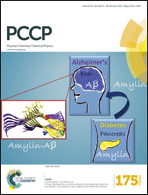Simulations of iron K pre-edge X-ray absorption spectra using the restricted active space method†
Abstract
The intensities and relative energies of metal K pre-edge features are sensitive to both geometric and electronic structures. With the possibility to collect high-resolution spectral data it is important to find theoretical methods that include all important spectral effects: ligand-field splitting, multiplet structures, 3d–4p orbital hybridization, and charge-transfer excitations. Here the restricted active space (RAS) method is used for the first time to calculate metal K pre-edge spectra of open-shell systems, and its performance is tested against on six iron complexes: [FeCl6]n−, [FeCl4]n−, and [Fe(CN)6]n− in ferrous and ferric oxidation states. The method gives good descriptions of the spectral shapes for all six systems. The mean absolute deviation for the relative energies of different peaks is only 0.1 eV. For the two systems that lack centrosymmetry [FeCl4]2−/1−, the ratios between dipole and quadrupole intensity contributions are reproduced with an error of 10%, which leads to good descriptions of the integrated pre-edge intensities. To gain further chemical insight, the origins of the pre-edge features have been analyzed with a chemically intuitive molecular orbital picture that serves as a bridge between the spectra and the electronic structures. The pre-edges contain information about both ligand-field strengths and orbital covalencies, which can be understood by analyzing the RAS wavefunction. The RAS method can thus be used to predict and rationalize the effects of changes in both the oxidation state and ligand environment in a number of hard X-ray studies of small and medium-sized molecular systems.


 Please wait while we load your content...
Please wait while we load your content...